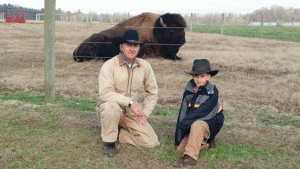
Give Him a Home Where the Buffalo Roam
James Rada, Jr.
Lewistown Elementary School student, Nik Contreras, hunches over a notebook, writing down figures for a loan he needs to buy a bison for his farm. Coming up with his total, he flips to another page and begins sketching a design for the corrals on his farm. It’s all part of his business plan.
Then the school bell rings and recess is over.
Nik is only nine years old, but he has a vision for his future, and it is centered around the huge shaggy animals from western lore, typically called buffalo.
“The settlers in the West knew about European buffalo, and, since bison looked like buffalo, that’s what they called them,” Contreras said.
A few years ago, Nik saw his first bison at a park in Virginia, and they captured his imagination. He liked their big heads and shaggy bodies.
He began drawing them in a sketchbook and searching for pictures on the internet of bison that he could use for models. He happened to click on one of those pictures, thinking it would enlarge, but instead it took him to the National Bison Association website.
He began exploring the website, learning more about bison and how to raise them for meat like cattle.
“People tell me why not raise cattle, but I say bison is better,” said Nik. “You don’t need to feed them as much. They can take care of themselves better than cows. You just need nice grass and water.”
Nik can tell you all about considerations for planning a ranch on which to raise bison. He continues researching them, because his plan is to eventually buy his own ranch.
His first step toward this goal is to buy his first bison. Many places around the country will sell bison at auction, just like a cattle auction. His research has allowed him to pick out an auction where he believes he can find the best deal. He has also found out that he can get an unsecured Rural Youth Agriculture loan for up to $5,000.
Now, he just has to turn ten, which will happen later this year.
Nik is now a junior member of the National Bison Association, and he also became the very first junior member of the Eastern Bison Association.
“They’re great people,” said Cindy Burnsteel, Nik’s mother. “They answer his e-mails and calls and treat him as they would any other adult.”
Since becoming interested in raising bison, Nik has attended different round-ups, visited a number of bison ranches, and even lobbied members of Congress about the benefits of bison meat.
“It tastes better than beef,” Nik said. “It’s a little sweeter. It’s also low in fat and cholesterol. You can use it to make a lot of things, like soup, tacos, and burgers.”
Nik even knows how he will raise the money to make loan payments and pay for the upkeep of his bison at a ranch. He is going to make bullwhips and sell them. It is a skill that he has been learning for quite some time, and he believes that he can make better ones than you can often purchase in stores.
Once the first bison he buys has had a few calves, he will sell it and raise the young ones. He will continue raising and breeding them, slowly growing his herd and his income until he has enough money to buy his first ranch. He figures that it will be in Michigan or Wisconsin.
Not surprisingly, he has also researched the places in the United States that have the best conditions for raising bison.
Bill Edwards of SB Farms in Hurlock, Maryland, and Nik Contreras are pictured, with bison bull, Captain Hook.
 Photo Courtesy of Cindy Burnsteel
Photo Courtesy of Cindy Burnsteel
 Photo Courtesy of Cindy Burnsteel
Photo Courtesy of Cindy Burnsteel